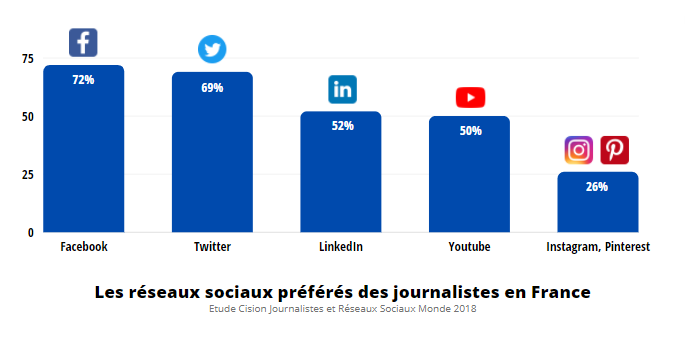They can't do without it anymore. This is what 55% of journalists say: social networks are indispensable. These new channels are transforming the relationship between journalists and communicators. Facebook, Twitter, Youtube... are now part of the communication strategy equation. How are social networks revolutionizing press relations? Explanations.
Social networks, new working tools for journalists
Almost all of them have already taken the plunge. 94% of journalists are present on social networks, according to the Cision Journalists and Social Networks World 2018 study. They use them on a daily basis as part of their work. A use that is not trivial: they spend an average of 2 hours a day on it - and between 4 hours and 8 hours for 10% of them!
At the top of the list of social networks most used by journalists: Facebook. This community-based social media is an open door to daily life - journalists use it in particular for calls for witnesses. Twitter comes in second place. More conversational, the social network with the blue bird is particularly appreciated for one of its features: Twitter Lists. They allow journalists to personalize and organize tweets by topic.

But how do they use it? Some examples:
-
To publish and promote their content. Often, journalists relay their own articles on their feed. Beyond "personal branding" and content creation, this is a new way to share their work with a new community: their subscribers.
-
To keep an eye on things. Twitter, Facebook... are goldmines of all kinds of content. Journalists use them to detect trends and find ideas for articles. But not only: monitoring is also used to keep an eye on other media.
-
To get informed. Social networks allow you to stay on top of the news at a glance. By following experts, personalities or companies, journalists can quickly access the latest content.
-
To measure the effectiveness of an article. In the race for KPIs, newcomers are making their appearance. Shares, Likes or retweets: they allow journalists to evaluate the success - or not - of an article. Useful indicators to judge the relevance of a topic or a format to readers. But don't be confused: the quality of a content is not only about the engagement it generates!
This list is not exhaustive. The most active ones share and interact regularly; others use them for purely informative purposes, without ever publishing... In short, there are as many uses of social networks as there are journalists.
More than a new working method, the professional use of social media by journalists is a new challenge for the press relations community, and especially for communicators. Twitter, Facebook... They invest them in their turn, with the objective: to go and find journalists where they are.
Press relations in the age of social networks
This is a ripple effect. The use of social networks by journalists is transforming press relations.
"Mobile-friendly" and "snackable": these anglicisms refer to the new formats published on social networks. These are short, visual contents that are easily shared. These are new practices available to communicators to attract the attention of the media on social networks: sending a tweet instead of a press release, creating video content, writing e-press kits that can be consulted directly online, infographics, sharing links, etc. Press relations have become digital.
Social networks are a new sounding board. They are revolutionizing press relations, bringing immediacy and spontaneity. "Social networks are part of the range of media we have to work with, in a different way than we did a few years ago," said Benjamin Perret, EDF's Director of Communications, during a presentation at B SMART in October 2021. Indeed, until then, the press release was de rigueur for each communication. Although effective, writing one takes time and imposes a certain formality on communicators. The emergence of social media has considerably changed habits. These new and complementary tools abolish distance and allow communicators to exchange with journalists in real time. At the same time, they offer greater freedom in content formats: "Digital technology brings responsiveness, creativity and a kind of decentralization of information that is interesting. It has invigorated us all," adds Benjamin Perret.
In the age of digital press relations, communicators can counter-argue, respond to errors, omissions ... immediately. Like Jacques-Emmanuel Saulnier, Director of Communications at TotalEnergies, who responded on Twitter to Audrey Garric, a journalist with Le Monde's Planet department.
In October 2021, the journalist shared on Twitter a link to her article Climate Change: How Total and Elf have been sowing doubt for decades. The article is based on a study showing that "the oil company, aware of the risks as early as 1971, questioned the scientific data that threatened their activities. These comments are quickly challenged by the director of communications of TotalEnergies: "It is wrong to argue that the climate risk would have been killed by Total in 70's." replied Jacques-Emmanuel Saulnier. A response in two tweets, visible to all: this is also the revolution of social networks on press relations.

Social media are therefore new points of contact between journalists and communicators. Digital PR implies different uses, an adaptation of formats... but without forgetting the traditional methods of press relations: the press release obviously still has its place in communication strategies. It's just that new, complementary tools are being added to the communicator's Swiss Army knife to attract media attention.
Emma Alcaraz

